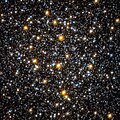Αρχείο:NGC 6362 globular cluster HST.jpg

Εικόνα σε υψηλότερη ανάλυση (3.061 × 3.061 εικονοστοιχεία, μέγεθος αρχείου: 6,78 MB, τύπος MIME: image/jpeg)
|
|
Αυτό το αρχείο και η περιγραφή του προέρχονται από το Wikimedia Commons. Οι πληροφορίες από την σελίδα περιγραφής του εκεί εμφανίζονται παρακάτω. |
Σύνοψη
| ΠεριγραφήNGC 6362 globular cluster HST.jpg |
Polski: Gromada kulista NGC 6362. Zdjęcie wykonane przez Teleskop Hubble'a. English: NGC 6362 - An unexpected population of young-looking stars
The NASA/ESA Hubble Space Telescope offers an impressive view of the centre of globular cluster NGC 6362. The image of this spherical collection of stars takes a deeper look at the core of the globular cluster, which contains a high concentration of stars with different colours. Tightly bound by gravity, globular clusters are composed of old stars, which, at around 10 billion years old, are much older than the Sun. These clusters are fairly common, with more than 150 currently known in our galaxy, the Milky Way, and more which have been spotted in other galaxies. Globular clusters are among the oldest structures in the Universe that are accessible to direct observational investigation, making them living fossils from the early years of the cosmos. Astronomers infer important properties of globular clusters by looking at the light from their constituent stars. For many years, they were regarded as ideal laboratories for testing the standard stellar evolution theory. Among other things, this theory suggests that most of the stars within a globular cluster should be of a similar age. Recently, however, high precision measurements performed in numerous globular clusters, primarily with the Hubble Space Telescope, has led some to question this widely accepted theory. In particular, certain stars appear younger and bluer than their companions, and they have been dubbed blue stragglers. NGC 6362 contains many of these stars. Since they are usually found in the core regions of clusters, where the concentration of stars is large, the most likely explanation for this unexpected population of objects seems to be that they could be either the result of stellar collisions or transfer of material between stars in binary systems. This influx of new material would heat up the star and make it appear younger than its neighbours. NGC 6362 is located about 25 000 light-years from Earth in the constellation of Ara (The Altar). British astronomer James Dunlop first observed this globular cluster on 30 June 1826. This image was created combining ultraviolet, visual and infrared images taken with the Wide Field Channel of the Advanced Camera for Surveys and the Wide Field Camera 3. An image image of NGC 6362 taken by the MPG/ESO 2.2-metre telescope will be published by the European Southern Observatory on Wednesday. See it on www.eso.org from 12:00 on 31 October. Credit: ESA/Hubble & NASA About the Image Id: potw1244a Type: Observation Release date: 29 October 2012, 10:00 Size: 3061 x 3061 px About the Object Name: NGC 6362 Type: • Milky Way : Star : Grouping : Cluster : Globular Distance: 25000 light years Colours & filters Band Wavelength Telescope Ultraviolet U 336 nm Hubble Space Telescope WFC3 Optical R 625 nm Hubble Space Telescope ACS Infrared I 814 nm Hubble Space Telescope ACS. |
| Ημερομηνία | |
| Πηγή | http://www.spacetelescope.org/images/potw1244a/ |
| Δημιουργός | ESA/Hubble & NASA |
| Άδεια (Επαναχρησιμοποίηση αυτού του αρχείου) |
http://www.spacetelescope.org/copyright/ |
| άλλες εκδόσεις |
 |
Αδειοδότηση
- Είστε ελεύθερος:
- να μοιραστείτε – να αντιγράψετε, διανέμετε και να μεταδώσετε το έργο
- να διασκευάσετε – να τροποποιήσετε το έργο
- Υπό τις ακόλουθες προϋποθέσεις:
- αναφορά προέλευσης – Θα πρέπει να κάνετε κατάλληλη αναφορά, να παρέχετε σύνδεσμο για την άδεια και να επισημάνετε εάν έγιναν αλλαγές. Μπορείτε να το κάνετε με οποιοδήποτε αιτιολογήσιμο λόγο, χωρίς όμως να εννοείται με οποιονδήποτε τρόπο ότι εγκρίνουν εσάς ή τη χρήση του έργου από εσάς.
Λεζάντες
Items portrayed in this file
απεικονίζει
29 Οκτωβρίου 2012
Ιστορικό αρχείου
Κλικάρετε σε μια ημερομηνία/ώρα για να δείτε το αρχείο όπως εμφανιζόταν εκείνη τη στιγμή.
| Ώρα/Ημερομ. | Μικρογραφία | Διαστάσεις | Χρήστης | Σχόλια | |
|---|---|---|---|---|---|
| τελευταία | 14:36, 4 Νοεμβρίου 2012 |  | 3.061 × 3.061 (6,78 MB) | Fabian RRRR | higher resolution: source (direct link) http://www.spacetelescope.org/images/potw1244a/ |
| 12:17, 3 Νοεμβρίου 2012 |  | 1.280 × 1.280 (715 KB) | Winiar | User created page with UploadWizard |
Συνδέσεις αρχείου
Τα παρακάτω λήμματα συνδέουν σε αυτό το αρχείο:
Καθολική χρήση αρχείου
Τα ακόλουθα άλλα wiki χρησιμοποιούν αυτό το αρχείο:
- Χρήση σε en.wikipedia.org
- Χρήση σε fr.wikipedia.org
- Χρήση σε ht.wikipedia.org
- Χρήση σε nl.wikipedia.org
- Χρήση σε pl.wikipedia.org
- Χρήση σε zh.wikipedia.org
Μεταδεδομένα
Αυτό το αρχείο περιέχει πρόσθετες πληροφορίες, πιθανόν από την ψηφιακή φωτογραφική μηχανή ή το scanner που χρησιμοποιήθηκε για την δημιουργία ή την ψηφιοποίησή της. Αν το αρχείο έχει τροποποιηθεί από την αρχική του κατάσταση, ορισμένες λεπτομέρειες πιθανόν να μην αντιστοιχούν πλήρως στην τροποποιημένη εικόνα.
| Τίτλος εικόνας |
|
|---|---|
| Online δήλωση πνευματικής ιδιοκτησίας | |
| Πηγή | ESA/Hubble |
| Αναφορά/Πάροχος | ESA/Hubble & NASA |
| Όροι χρήσης |
|
| Συνοπτικός τίτλος |
|
| Ημερομηνία και ώρα της παραγωγής ψηφιακών δεδομένων | 10:00, 29 Οκτωβρίου 2012 |
| Κατάσταση πνευματικών δικαιωμάτων: | Δεν έχει οριστεί καθεστώς πνευματικών δικαιωμάτων |
| Λέξεις κλειδιά | NGC 6362 |
| Στοιχεία επικοινωνίας |
http://www.spacetelescope.org/ Karl-Schwarzschild-Strasse 2 Garching bei München, , D-85748 Germany |
